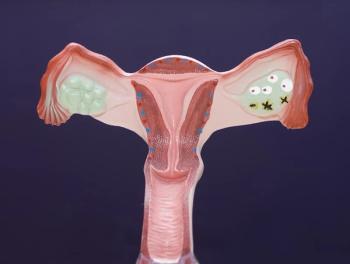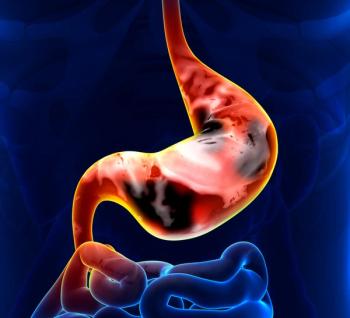
FDA Receives sNDA for Relacorilant in Platinum-Resistant Ovarian Cancer
Relacorilant plus nab-paclitaxel led to a median PFS and OS of 6.54 months and 15.97 months, respectively, in patients with platinum-resistant ovarian cancer.
A supplemental new drug application (sNDA) for relacorilant—a proprietary, selective cortisol modulator—in platinum-resistant ovarian cancer has been submitted to the FDA, according to a news release from the developer, Corcept Therapeutics, Incorporated.1
Results supporting the sNDA come from the pivotal phase 3 ROSELLA trial (NCT05257408) as well as phase 2 trials. It was noted that patients who received relacorilant plus nab-paclitaxel (Abraxane) demonstrated improved progression-free survival (PFS) and overall survival (OS) compared with patients who received nab-paclitaxel monotherapy.
In June 2025, data from the primary analysis of ROSELLA were published in The Lancet.2
With a median follow-up of 9.0 months (95% CI, 7.5-9.8), the median PFS per blinded independent central review (BICR) was 6.54 months (95% CI, 5.55-7.43) with relacorilant plus nab-paclitaxel and 5.52 months (95% CI, 3.94-5.88) with nab-paclitaxel monotherapy (HR, 0.70; 95% CI, 0.54-0.91; P = .0076). Investigator-assessed PFS results were consistent with what was found via BICR, with an HR of 0.71 (95% CI, 0.57-0.89; P = .0030).
An analysis of OS was also conducted at the interim analysis with a median follow-up of 13.9 months (95% CI, 13.3-14.9), which revealed a median OS of 15.97 months (95% CI, 13.47-not reached) in the combination group and 11.50 months (95% CI, 10.02-13.57) in the monotherapy group (HR, 0.69; 95% CI, 0.52-0.92; P = .0121). Furthermore, at the 12-month landmark, a total of 60.0% of patients were alive in the combination group vs 49.0% in the monotherapy group.
PFS per BICR and OS were favorable with relacorilant plus nab-paclitaxel vs nab-paclitaxel monotherapy in all clinically relevant subgroups.
The objective response rate (ORR) per investigator assessment was 36.9% with the combination and 30.1% with the monotherapy (P = .017), and the clinical benefit rate, at 24 weeks, was 51.1% vs 38.9%, respectively (P = .016).
“This submission is an important milestone for Corcept as we now have 2 new drug applications before the FDA: relacorilant in combination with nab-paclitaxel as a treatment for people with platinum-resistant ovarian cancer and relacorilant as a treatment for patients with hypercortisolism,” Joseph K. Belanoff, MD, Corcept’s CEO, said in the press release.1 “Better treatment options are needed for the many patients living with these diseases. Our oncology and endocrinology business units are already working to make sure relacorilant is available immediately following regulatory approval.”
Investigators of ROSELLA randomly assigned a total of 381 patients to receive the combination therapy (n = 188) or the monotherapy (n = 193). Treatment in the combination group consisted of 150 mg of oral relacorilant on the day before, the day of, and the day after receiving nab-paclitaxel and intravenous nab-paclitaxel at 80 mg/m2 on days 1, 8, and 15 of each 28-day cycle; in the monotherapy group, patients received intravenous nab-paclitaxel at 100 mg/m2 on days 1, 8, and 15 of each 28-day cycle. It was noted that patients in the combination group received a smaller dose of nab-paclitaxel because relacorilant is a CYP3A4 inhibitor that metabolizes nab-paclitaxel.
Eligible patients were women 18 years or older with a confirmed diagnosis of platinum-resistant epithelial, ovarian, primary peritoneal, or fallopian tube cancer who received 1 to 3 prior lines of systemic anticancer therapy and had progression or intolerance to the most recent therapy. Additionally, patients had measurable disease per RECIST v1.1, an ECOG performance status of 0 or 1, and adequate organ function.
No response to initial platinum-containing regimens, disease progression within 1 month of last dose of first-line platinum therapy, or ongoing requirement of chronic corticosteroids were reasons for trial exclusion.
Those in the combination group and the monotherapy group had a median age of 61.0 years and 62.0 years, respectively; 72% and 66% had an ECOG performance status of 0; 59% and 59% had stage I to III disease at diagnosis; 49% and 46% received 2 prior lines of systemic therapy; and 64% and 58% received 0 prior lines of therapy in the platinum-resistant setting.
It was noted that 39% of all patients received at least 1 line of therapy in the platinum-resistant setting, 19% had a taxane in their last line of therapy, and 4% received a taxane for platinum-resistant disease. It was highlighted that 7% of patients progressed within 3 months of their last dose of frontline platinum therapy and met primary platinum-refractory definitions from pivotal trials.
The dual primary end points were PFS per BICR and OS. Secondary end points included investigator-assessed PFS, ORR, best overall response, duration of response, clinical benefit rate, and safety.
Regarding safety, any-grade and grade 3 or higher adverse events (AEs) occurred in 100% and 74% of the combination group and 99% and 59% of the monotherapy group. Serious AEs occurred in 35% and 32% of the combination group and 24% and 21% of the monotherapy group. The most common AEs of any grade and grade 3 or higher in the combination group were neutropenia (64% and 44%), anemia (61% and 18%), fatigue (53% and 9%), and nausea (44% and 4%); in the monotherapy group, they were anemia (55% and 8%), neutropenia (49% and 25%), fatigue (45% and 2%), and nausea (35% and 3%).
AEs led to treatment interruptions in 73% of the combination group and 55% of the monotherapy group and death in 2% and 0%. Dose reductions due to AEs in the combination group were due to relacorilant in 7% and nab-paclitaxel in 48%, and in the monotherapy group, they were due to nab-paclitaxel in 32%. Treatment discontinuations following AEs in the combination group were due to relacorilant in 10% and nab-paclitaxel in 9%, and in the monotherapy group, they were due to nab-paclitaxel in 8%.
“The ROSELLA trial met its primary objective: The addition of relacorilant to nab-paclitaxel for patients with platinum-resistant ovarian cancer showed a statistically significant improvement in PFS assessed by BICR and a clinically meaningful difference in OS at an interim analysis,” wrote the ROSELLA study authors in the paper.2
Additionally, the developer conducted 2 phase 2 trials: the completed phase 2 CORT125134-552 trial (NCT03776812), which evaluated intermittent or continuous regimens of relacorilant plus nab-paclitaxel in a similar population, and the currently recruiting phase 2 CORT125134-557 trial (NCT06906341), which will evaluate intermittent dosing of relacorilant plus nab-paclitaxel and bevacizumab (Avastin).
References
- Corcept submits new drug application for relacorilant as a treatment for patients with platinum-resistant ovarian cancer. News release. Corcept Therapeutics Incorporated. July 14, 2025. Accessed July 15, 2025. https://tinyurl.com/re6betf5
- Olawaiye AB, Gladieff L, O'Malley DM, et al. Relacorilant and nab-paclitaxel in patients with platinum-resistant ovarian cancer (ROSELLA): an open-label, randomised, controlled, phase 3 trial. Lancet. 2025;405(10496):2205-2216. doi:10.1016/S0140-6736(25)01040-2
Newsletter
Stay up to date on recent advances in the multidisciplinary approach to cancer.


















































































